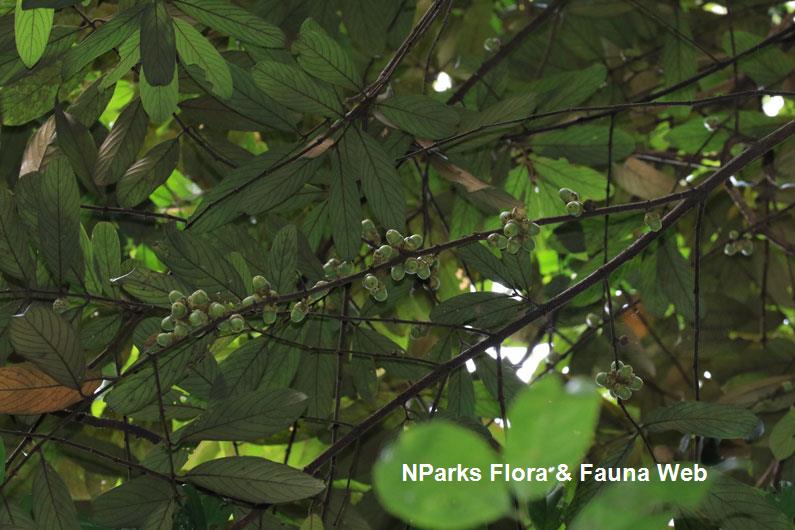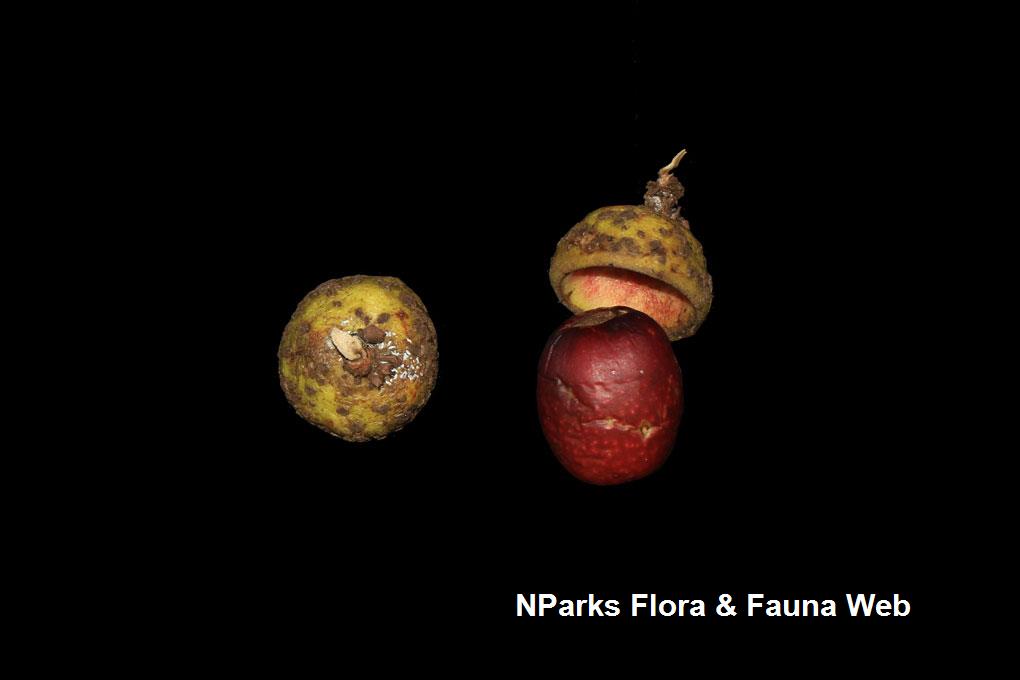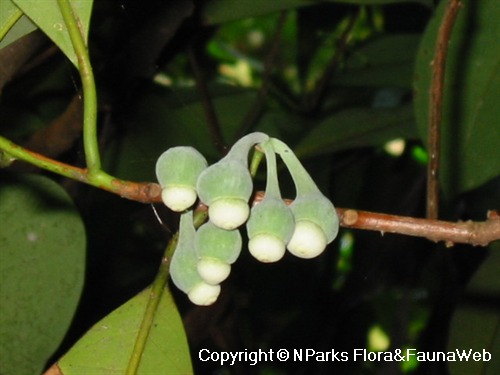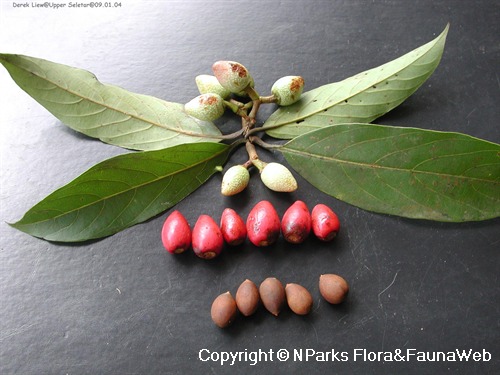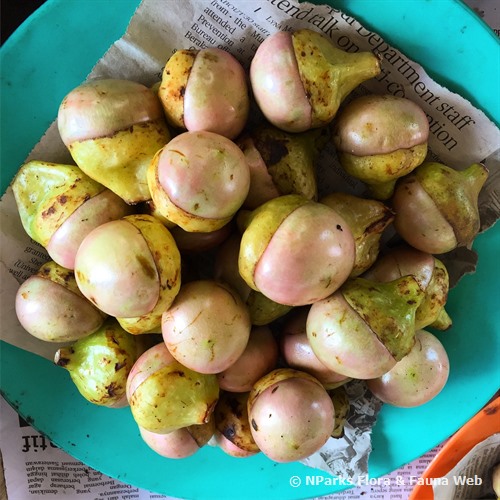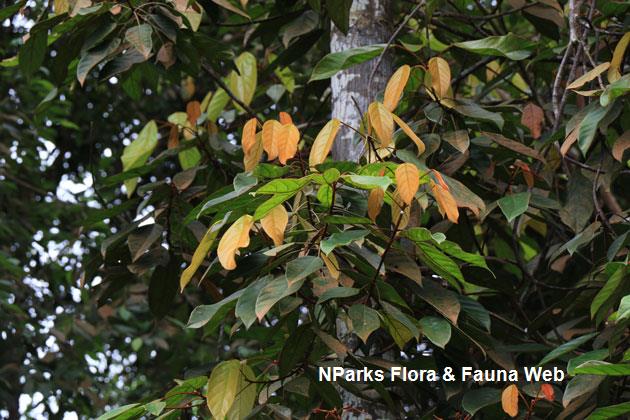
Back
Litsea ferruginea (Blume) Blume
| Family Name: | Lauraceae |
| Synonyms: | Litsea griffithii Gamble |
| Common Name: | Medang pinang |
Litsea ferruginea or Medang pinang is a medium-sized tree native to Singapore. Growing to 25 m tall, it has elliptic to obovate leaves that are pinkish-orange when young. The underside is glaucous covered in reddish-brown hairs. The petiole is swollen at the base, covered in reddish-brown hairs. Flowers are dioecious, cream, pale green or bright yellow coloured, borne on an inflorescence found along the axils. The fruit is an elliptic to globose, warty, single-seeded berry. Upon maturity, it turns from green to dull red to black. The berry sits deep within a fleshy, smooth to warty cap (cupule).
Name
Classifications and Characteristics
| Plant Division | Angiosperms (Flowering Seed Plants) (Dicotyledon) |
|---|---|
| Plant Growth Form | Tree (Medium (16m-30m)) |
| Maximum Height | 25 m |
Biogeography
| Native Distribution | Peninsular Thailand, Peninsular Malaysia, Singapore, Sumatra, Java and Philippines |
|---|---|
| Native Habitat | Terrestrial (Primary Rainforest, Secondary Rainforest) |
| Preferred Climate Zone | Tropical |
| Local Conservation Status | Native to Singapore (Critically Endangered (CR)) |
Description and Ethnobotany
| Growth Form | It is a medium-sized tree that can grow between 6 - 25 m tall. Buttresses can reach to 1 m in height. |
|---|---|
| Foliage | Leaves are elliptic to spoon-shaped, measuring 6 - 42 cm long by 2 - 15 cm wide, young leaves are pinkish-orange. Matured leaves are dark or bright green above, greyish below covered with reddish brown hairs. There are 8 - 12 pairs of lateral veins looping near the margins, raised on the underside. Leaves are held on a short petiole of 0.5 - 2.5 cm long, swollen at the base, covered in reddish-brown dense hairs. |
| Flowers | Flowers are dioecious where the female and male flowers are held on separate individuals. Borne on an inflorescence along the axils, the flowers are cream to pale green or bright yellow coloured. |
| Fruit | The fruit is elliptic to globose, warty, single-seeded berry measuring 8 - 25 mm long by 13 - 14 mm wide. Upon maturity, it turns from green to dull red to black. The berry sits on a fleshy, smooth to warty cupule measuring 15.6 - 19 mm wide, 11 - 16 mm deep. |
| Others - Plant Morphology | When crushed, the leaves and fruit produce an aromatic fragrance. |
| Habitat | Occurs in primary, secondary lowland and hill forests, up to 330 m in altitude. <1&2> |
| Cultivation | It can be propagated by seed. |
| Etymology | The species epithet ferruginea, meaning rusty-brown coloured in reference to the colour of hairs found on the twigs and leaves. |
Plant Care and Propagation
| Light Preference | Full Sun |
|---|---|
| Water Preference | Moderate Water |
| Plant Growth Rate | Moderate |
| Rootzone Tolerance | Fertile Loamy Soils, Well-Drained Soils, Moist Soils |
| Propagation Method | Seed |
Foliar
| Mature Foliage Colour(s) | Green - Light Green, Green, Silver / Grey |
|---|---|
| Foliar Type | Simple / Unifoliate |
| Foliar Arrangement Along Stem | Opposite |
| Foliar Attachment to Stem | Petiolate |
| Foliar Shape(s) | Non-Palm Foliage (Elliptical, Obovate) |
| Foliar Venation | Reticulate |
| Foliar Margin | Entire |
| Foliar Apex - Tip | Acute, Rounded |
| Foliar Base | Cuneate |
Non - Foliar and Storage
| Stem Type & Modification | Woody |
|---|
Floral (Angiosperm)
| Flower & Plant Sexuality | Unisexual Flowers , Dioecious |
| Flower Colour(s) | Cream / Off-White, Green - Light Green, Yellow / Golden |
|---|
Fruit, Seed and Spore
| Mature Fruit Colour(s) | Black |
|---|---|
| Fruit Classification | Simple Fruit |
| Fruit Type | Fleshy Fruit , Berry |
References
| References | <1> Davison, G. et. al. (2024) The Singapore Red Data Book, 3rd ed. Singapore: National Parks Board, Singapore Botanic Gardens. <2> de Kok, R.P.J. (2021). A revision of Litsea (Lauraceae) in Peninsular Malaysia and Singapore. Gardens' Bulletin Singapore 73(1): 122-124. |
|---|
Image Repository
Others
| Master ID | 30082 |
|---|---|
| Species ID | 4391 |
| Flora Disclaimer | The information in this website has been compiled from reliable sources, such as reference works on medicinal plants. It is not a substitute for medical advice or treatment and NParks does not purport to provide any medical advice. Readers should always consult his/her physician before using or consuming a plant for medicinal purposes. |


